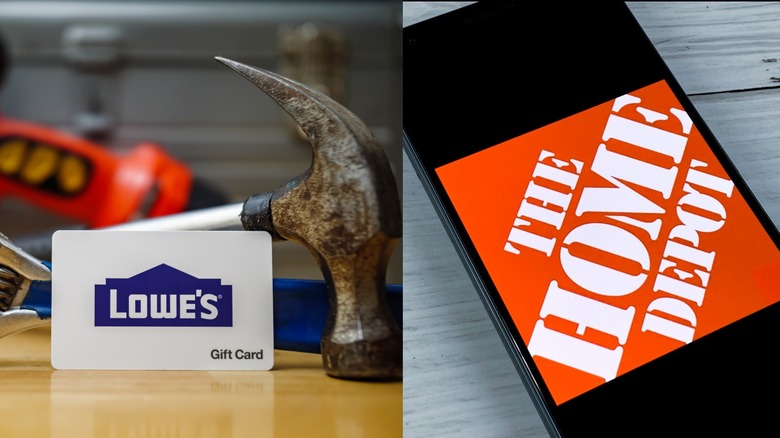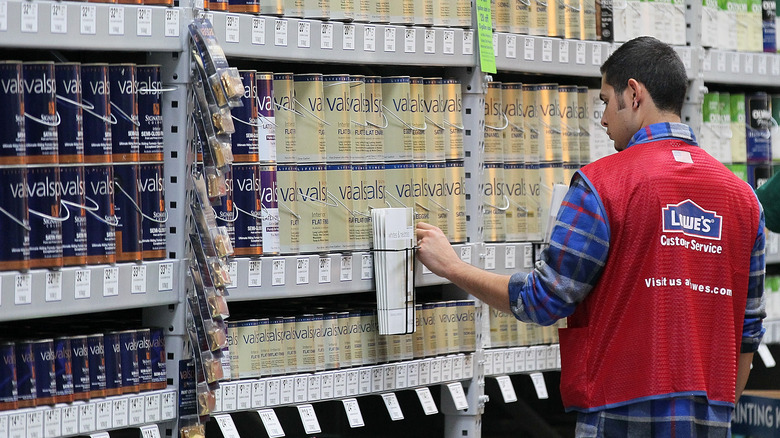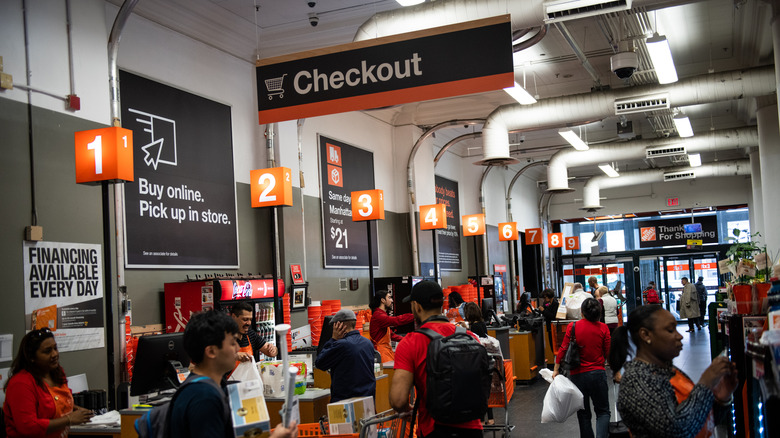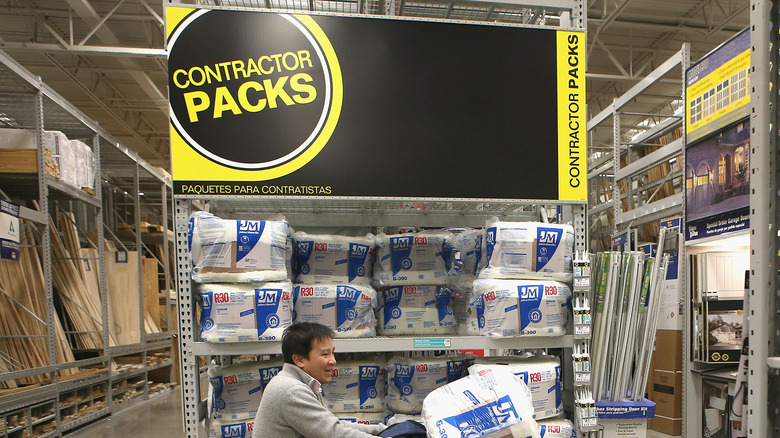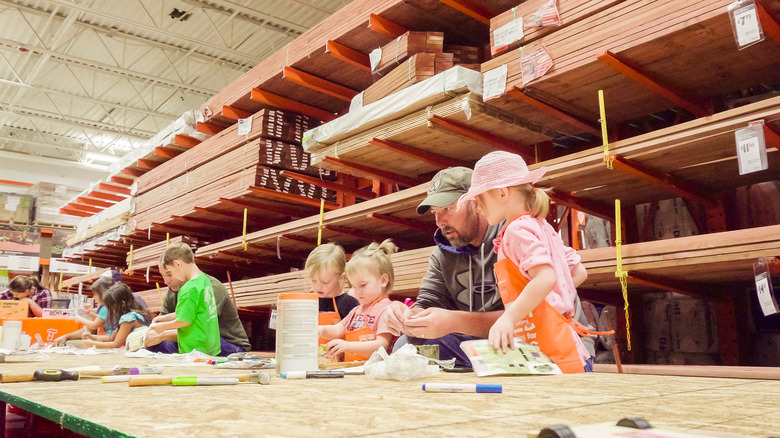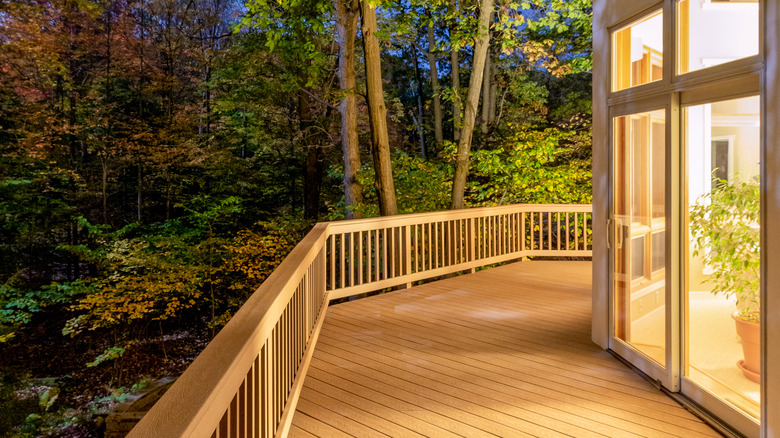What's The Difference? Lowe's Vs. Home Depot
Home Depot and Lowe's seem to be often mentioned in the same sentence. These two stores are also featured in almost the same location for many residents, sometimes as close as next door. These similarities have often made Home Depot and Lowe's the subject of rumors. For example, according to Snopes, there's an urban myth floating around that claims these two retailers were once the same store. The store was said to be owned by a husband and wife who became embattled in a bitter divorce. To divide the marital assets, each got a home improvement chain, but their settlement required the exes to build stores in the same place so both could flourish in business.
While it is true that some chains have "sister stores" like Olive Garden and Red Lobster, it is false that there is any direct relationship between Lowe's and Home Depot management. There are similarities to be found in these home improvement giant retailers for sure, but there are also many differences. Some of those differences just might surprise you.
Overall corporate comparison
Lowe's and Home Depot have some significant differences at the corporate level. According to Comparably, based on customer ratings, Lowe's ranks #127 in Global Top 1000 Brands while Home Depot ranks #85 in the Top 100. If playing the stock market, Lowe's current market cap is $136.7 billion, and Home Depot's is $301.06 billion. Employees generally rank Home Depot's corporate culture, CEO, and basic work conditions higher than Lowe's employees, although neither store has high negative marks.
Fact-checkers at Snopes also describe a difference in how and when these two retailers were founded. Lowe's began in North Carolina (which may explain its Nascar fandom) in 1946 as a hardware store run by two brothers-in-law, James Lowe and Carl Buchan. Within a few years of opening, Buchan bought out Lowe but kept the name and ran the company until he died in 1961, which was when the store went public. Lowe's hit the New York Stock Exchange in 1979 and by the 2000s had hit the billion-dollar range. Home Depot is younger. It was founded in 1978 in Atlanta, Georgia, by Bernard Marcus, Arthur Blank, and Kenneth Langone. The company went public in 1981 and boasted thousands of stores and significant sales by the 2000s. Yet while Home Depot is younger, it is currently the larger of the two home improvement chains.
Difference in stores and real estate
Investopedia reminds us that Home Depot and Lowe's are the two largest home improvement retailers in the world, as reflected in their annual company reports and other data. These stores carry quite a large real estate footprint in the United States and Canada. Lowe's stores average about 112,000 square feet of enclosed space and approximately 32,000 additional garden center areas. Home Depot alternatively has around 105,000 square feet of enclosed space and a slightly smaller garden area (24,000 square feet).
As of March 2020, Home Depot had 2,287 stores across the U.S., U.S. territories, Canada, and Mexico. Home Depot had stores in China as well, but these shuttered in 2012. Lowe's has 2,002 stores in the United States and Canada, closing its own overseas efforts in Australia in 2016. While Lowe's has more space, Home Depot has more stores. Lowe's operates 15 mechanized distribution centers in the United States and seven in Canada when it comes to distribution centers. In comparison, Home Depot operates 20 distribution centers in Texas alone, according to The Business Journals. Lowe's has been running on modern mechanization for longer, while Home Depot began its modernization process in 2009.
Difference in revenue and sales
Lowe's might have seniority and win the square footage race, but Home Depot is the clear leader in revenue and sales. Statista shows this revenue trend as a long-term differentiator between the two brands. In 2020 Home Depot reported $132.11 billion in sales while Lowe's reported $89.6 billion. That's a $42.51 billion difference. In 2016 Home Depot reported $94.06 billion to Lowe's $65.02 billion, and in 2011 Home Depot reported $70.4 billion to Lowe's $50.21 billion in sales. While Home Depot may lead in numbers, both brands are clearly strong and growing.
When it comes to stock prices, Home Depot was $408.81 a share and Lowe's $255.05 a share at the time of publication (via Google Finance). The Motley Fool suggests that there may be more long-term potential in a Home Depot investment but notes that these two brands essentially have a "duopoly" on the market.
Difference in commercial services
Professional and commercial services can draw in large percentages of a retailer's revenue, which is true for both Home Depot and Lowe's. Just imagine the cost difference between a single DIY bathroom and a contractor who plans to remodel an entire apartment building to understand the scale of these sales. Lowe's reports about 20% to 25% of sales in professional contracts, while Home Depot reports 45% in similar professional contracts.
There might be a reason why Home Depot is pulling in more contracts. "They want to use products they know they can trust, and Home Depot has better brands," Seth Basham, the managing director of equity research at Wedbush Securities, tells Insider. Also contributing to these numbers is the fact that while single-item purchases across both brands are very similar in price, bulk package pricing is slightly more competitive at Home Depot. This can change costs significantly for contractors at scale. But while Home Depot leads in commercial services right now, things are always subject to change at both a professional and DIY level.
Difference in consumer classes and DIY
Home Depot and Lowe's offer similar consumer and DIY services, but there are still subtle differences. Where Home Depot leads in contractor services, Insider notes Lowe's has an edge in DIY services. Specifically, there was much more staff assistance available for amateurs with questions. ComboReviews notes that Lowe's offers twice-monthly children's building clinics, while Home Depot offers a kid's clinic once per month. Home Depot has been noted for adding women's DIY clinics, while Lowe's has grabbed millennial attention on social media and free online information.
The Spruce conducted a thorough dive into Yelp reviews of both stores and found their scores to be about even, with customers finding similar levels of store access, customer service, staff, and pricing.
Difference in product lines
If you feel strongly about a product line, this might be a big reason to choose one store over the other. For example, Lowe's carries the composite decking line ChoiceDek, while both Home Depot and Lowe's carry the competing line called Trex, as shared by Consumer Reports. The Spruce also notes that each store has exclusive tool lines. Lowe's carries Kobalt and Task Force while Home Depot stocks Husky and Ryobi. It turns out that both Kobalt and Husky tools generate a large number of 1-star reviews at each store, once again balancing the stores' approval ratings.
Their paint departments also carry different brands, with Lowe's stocking Valspar and some Sherwin-Williams items and Home Depot having Behr and Glidden. It's noted that new Pella windows are also a Lowe's exclusive. Deciding which brand you need often comes down to a choice of availability, color match, and price, so which store you prefer may really depend on the project.
Difference in sponsorship and advertising
When it comes to public sentiment, Comparably notes that Lowe's has a neutral perception while Home Depot has a negative one, despite Home Depot ranking higher in customer service, product quality, and pricing in their metrics. This might have to do with how much PR each brand does.
Snopes explains that Lowe's has been reported as awarding $25 million to minority-owned businesses during the pandemic, while Home Depot's founder donated $7 million to the polarizing Donald Trump. CNBC confirms that Lowe's announced a $25 million minority grant program in 2020 and has a previous history of charity work as well. Open Secrets confirms that Home Depot co-founder Bernie Marcus donated $7 million to the Trump campaign in 2016, but the Snopes team notes that he retired from the company in 2002, meaning this wasn't a direct company sponsorship. When it comes to political donations, both companies have openly donated to both Republican and Democratic candidates. And while both groups were previously large sponsors of Nascar, USA Today notes that neither company is currently in the race car business, with Lowe's being the last to decline sponsorship in 2018.
